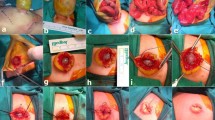Abstract
Arterial catheterization is an important adjunct to the management of critically ill neonates. We report our experience with umbilical artery cutdowns in 30 neonates in whom the umbilical artery was cannulated through a mini-laparotomy. In 29 of 30 cases (97%) successful cannulation was achieved. The mean gestational age was 31.4 weeks, and 8 neonates weighed less than 1000 g. The duration of catheter use ranged from 1 to 30 days, with a mean of 7 days. There were no complications resulting in long-term disability. A review of the literature discusses the various techniques of arterial catheterization in critically ill newborns. We conclude that umbilical artery catheterization by cutdown can be a reliable and relatively safe means of obtaining arterial access in critically ill neonates.
Similar content being viewed by others
References
Caeton AJ, Goetzman BW (1985) Risky business: umbilical arterial catherization. Am J Dis Child 139: 120–121
Clark JM, Jung AL (1977) Umbilical artery catheterization by a cutdown procedure. Pediatrics 59: 1036–1040
Cochran WD, Davis HT, Smith CA (1968) Advantages and complications of umbilical artery catheterization in the newborn. J Pediatr 42: 769–777
Filston HC, Izant RJ (1975) Translocation of the umbilical artery to the lower abdomen: an adjunct to the postoperative monitoring of arterial blood gases in major abdominal wall defects. J Pediatr Surg 10: 225–229
Hashimoto T, Togari H, Yura J (1985) Umbilical artery cutdown: an improved procedure for re-insertion. Br J Surg 72: 194
Johns AW, Kitchen WH, Leslie DW (1972) Complications of umbilical vessel catheters. Med J Aust 2: 810–815
Kaufman JM, Pai S, Austin TL (1983) Neonatal bladder injury occurring after umbilical artery catheterization by cutdown. JAMA 250: 2968–2970
Marsh JL, King W, Barrett C (1975) Serious complications after umbilical artery catheterization for neonatal monitoring. Arch Surg 110: 1203–1208
Moore TC, Leake RD (1977) Intraumbilical entry into the peritoneal cavity through a small incision for the identification and cannulation of an umbilical artery. J Pediatr Surg 12: 247–249
Randel SN, Tsang BH, Wung JT (1987) Experience with percutaneous indwelling peripheral arterial catheterization in neonates. Am J Dis Child 141: 848–851
Sherman NJ (1977) Umbilical artery cutdown. J Pediatr Surg 12: 723–724
Waffarn F, Devaskar UP, Hodgman JE (1980) Vesico-umbilical fistula: a complication of umbilical artery cutdown. J Pediatr Surg 15: 211
Zerella JT, Trump DS, Dorman GW (1979) Access for neonatal arterial monitoring. J Pediatr Surg 14: 270–275
Author information
Authors and Affiliations
Additional information
Offprint requests to: P. J. Wolfson
Rights and permissions
About this article
Cite this article
Singer, R.L., Wolfson, P.J. Experience with umbilical artery cutdowns in neonates. Pediatr Surg Int 5, 295–297 (1990). https://doi.org/10.1007/BF00169677
Accepted:
Issue Date:
DOI: https://doi.org/10.1007/BF00169677




